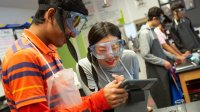Creating Video Guides to Prepare Students for Science Labs
Teachers can share detailed instructions ahead of time so students arrive at the lab ready to maximize their experiential learning.
Your content has been saved!
Go to My Saved Content.Today is brain dissection day, and the excitement is palpable. Some students shriek when they see a brain on my desk. Questions come rapid-fire: “What does it feel like?” “Why does it look like that?” “Where do you get them?”
Once the class has settled down, I spend much of the lesson front-loading information. I go over the necessary materials, spell out the procedure, review the technique, explain how data will be collected, and demonstrate the dissection. Now, at the part of the lesson where the students are working in small groups, one group takes off ahead of the others, only to have missed a step, and now it’s too late because their brain specimen is already in pieces. Others are moving at a glacial pace, fearful of making a mistake or waiting on me to ask a question.
My students have little time for experiential learning because I have to spend the majority of class time front-loading. And at this point in the lesson, with only a few minutes remaining, I feel like I’m putting out fires all over the place. I quickly explain how to clean up, which they do with varying degrees of care.
I know my students have had an unforgettable experience, but what did they learn? We only had a few moments to talk about what they were seeing and how it related to the course content.
To find out if my colleagues’ experiences were similar to mine, I created a survey and shared it with two Facebook groups, AP Biology Teachers and Human Anatomy and Physiology Teachers. When I asked 451 science teachers why they include laboratory experiences in their classes, 449 responded that it is not to teach students how to follow procedures. Yet the majority of our time is spent explaining what to do and how to do it.
However, there is a better way.
Using Prerecorded Videos as a Learning Aid
It would be wonderful to have a teacher’s aide to assist each laboratory group so that students could focus on how the laboratory connects to course content and theory, but that number of aides is a pipe dream. However, with a decent video camera, microphone, and video editing software, one teacher can provide a guide in the form of prerecorded laboratory instructions for every student group.
Using prerecorded video directions has numerous advantages. Students are experiencing cognitive overload at the start of a laboratory, making it easy for them to miss important instructions. Prerecorded instructions, which can be rewatched as needed, solve this problem. Recorded directions provide auditory and visual reinforcement, as well as written cues. The audio and visual cues can help students who have trouble reading. It’s simple to direct students to the video when they have questions about laboratory procedures, freeing you up as the teacher to answer content-related questions or confer with students to assess understanding.
If creating video instructions for laboratories sounds like something you’d like to try, there are a few things you should know. Break up your instructional video into segments because the ideal length for instructional videos is about 6 minutes. Make use of online platforms that allow you to insert questions or notes into the video. For instance, I might start a video by explaining the lab materials for the day’s lesson, then include a note in the video with a list of materials that students should gather.
I recently used Edpuzzle to create a video and quiz to accompany a lab on the functionality of enzymes under different conditions, as well as Microsoft Sway to create a sheep brain dissection manual. Check out Cult of Pedagogy’s “Everything You Need to Know About Building a Great Screencast Video” for more information on how to make an effective screencast video.
Don’t take it for granted that your students will know how to use your videos. Make sure they have seen a video before using it in their groups. First, introduce the video by having students watch it individually or as a class so they are familiar with it. Then, once in groups, they can rewatch it as needed while completing the laboratory activity.
The Advantages of Using Technology to Assist Student Learning
Using prerecorded videos allows me to spend more time with my students on other activities. I can now focus on small group discussions about theory instead of explaining laboratory procedures.
I spend more time answering application and analysis questions than putting out fires or re-explaining instructions. I can now evaluate students while they work by conducting a quick interview with each group member. This time spent talking with students rather than at them allows me to gain a better understanding of which groups work well together and encourages students to take charge of their own learning.
Video directions can provide an opportunity to provide extension activities for fast-moving groups while maintaining the learning of groups still working on their laboratories. Those who finish my chicken wing dissection early, for example, are challenged to investigate structures not covered in the day’s lab while others continue to work. I give them a light microscope as well as slides with which to examine tissues.
For students, laboratories are memorable. While completing them, teachers and students should not become stressed or anxious. Students can learn and grow without the overload that often comes with lab classes by watching prerecorded instructional videos.
